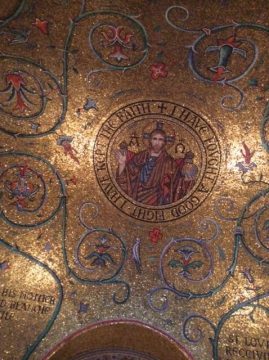Alleluia, Jesus has ascended into heaven! As we celebrate the mystery of the Ascension, please find a Franciscan Gospel reflection and questions written by Fr. Paul Gallagher, OFM for your prayer. They are edited by Franciscan Sister of Christian Charity Sister Anne Marie Lom and Joe Thiel. The excerpts from the Sunday readings are prepared by Joe Thiel. To read or download the complete pdf with excerpts for your prayer, please click here: Excerpts are from the Lectionary for Mass for Use in the Dioceses of the United States of America, second typical edition © 2001, 1998, 1997, 1986, 1970 Confraternity of Christian Doctrine, Inc., Washington, DC. Used with permission. All rights reserved. No portion of this text may be reproduced by any means without permission in writing from the copyright owner. Photos: Cathedral Basilica of St. Louis, Missouri, Holy Name of Jesus Cathedral, Raleigh, North Carolina
Matthew 28:16-20
[Most Dioceses in the United States have moved the celebration of The Ascension of the Lord to the Seventh Sunday of Easter. Therefore, the gospel text here is for that feast.]
The eleven disciples went to Galilee, to the mountain to which Jesus had ordered them. When they saw him, they worshiped, but they doubted. Then Jesus approached and said to them, “All power in heaven and on earth has been given to me. Go, therefore, and make disciples of all nations, baptizing them in the name of the Father, and of the Son, and of the Holy Spirit, teaching them to observe all that I have commanded you. And behold, I am with you always, until the end of the age.”
Background:
By separating the resurrection from the ascension, the Church gives us the opportunity to pray and reflect on two aspects of a single event, the resurrection of Jesus from the dead. For several centuries, the church did not treat the ascension as a separate event; instead it was understood as part of Jesus’ resurrection.
In Matthew’s gospel, there are only two appearances of the risen Jesus. The first is when Jesus meets the two Marys as they leave the empty tomb. He instructs them to tell the disciples to meet him in Galilee. The second time is the mountaintop experience that is described in the text for today’s gospel, which is Matthew’s last five verses. Matthew’s text does not support any reason to separate the two appearances.
The idea that the ascension is a historical event, where Jesus rose from the grave but waited for some time to be with and teach the disciples a few last things before returning to the Father, is not supported by the scripture texts like the gospel for this feast, where Jesus says, “All power in heaven and on earth has been given to me.” (Verse 19) This kind of proclamation would not occur if Jesus is still in some state of transition between death and full communion with the Father and Holy Spirit.
The gospel text for today demonstrates that the two Marys were faithful to what they were commissioned to do, “Go tell the disciples.” Despite being caught in the two emotions of joy and fear, they acted. The first verse of the text also describes disciples being faithful to what Jesus asked of them. They were instructed to go to Galilee to meet Jesus. On seeing Jesus, they too were caught between two emotions: doubt and worship. They were commissioned “to make disciples of all the nations.” (Matthew 28:19) Jesus’ earlier instruction to the disciples, not to enter a pagan or Samaritan area, is set aside. (Matthew 10:5) With the resurrection, all cultural and ethnic distinctions and boundaries have been breached or dissolved. They are to “Baptize in the name of the Father, the Son, and Holy Spirit.” This is not the full expression of a developed Trinitarian theology of God, but it is the beginning. The fact that we, and people of every race, language, orientation, and way of life, are gathering to celebrate this feast is evidence that they, too, and generations after them, have been faithful to what Jesus commissioned all of us to do.
Reflection Questions
- Who are some of the people you have had to say good-bye to in recent years?
- Were any of those departures that needed to take place for the development of the other person?
- How do you think the disciples felt about the women telling them that they should go to Galilee? What might Galilee have symbolized for them?
- The text says that when the disciples saw Jesus, they worshiped and doubted. How do you understand them both worshiping and doubting?
- Who were the significant people who taught you about your relationship with God and God’s desire to be in relationship with you?
- If you were one of those disciples being told “All power in heaven and on earth has been given to me. Go, therefore, and make disciples of all nations, baptizing them in the name of the Father, and of the Son, and of the Holy Spirit, teaching them to observe all that I have commanded you. And behold, I am with you always, until the end of the age.” What would you be going through you as Jesus spoke to you?
- Is there a difference between a community who feels that it is essential that they share the gospel with others and a community that does not take that responsibility seriously?
- How do you hear Jesus’ statement at the end of the text: “And behold, I am with you always, until the end of the age?”
- Can you take some time now to talk with God about whatever strikes you most in this text? Try to speak from your head, and from your heart, honestly to God.




